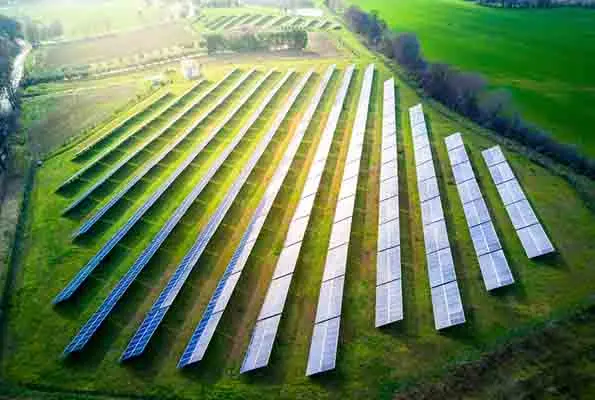India may be creating the world’s largest renewable energy facility. The solar and wind farms will rise from the salt desert in three years.
Developers say the Khavda renewable energy park in the Indian state of Gujarat, named after the community nearest the project site, will be visible from space.
The project will cover 726 square kilometres, approximately as large as Singapore. India believes it will cost USD 2.26 billion (2.08 billion euros).
The COP28 climate meeting saw leaders wanting to triple renewable energy worldwide in any final agreement while reducing coal, oil, and natural gas use.
Powering 18 Million Homes
After its completion, the park will generate 30 gigawatts of renewable energy, enough to power 18 million Indian households.
The world’s most populous country India wants to install 500 gigawatts of sustainable energy by the end of the decade and reach net zero emissions by 2070. This project site will likely help it switch to non-carbon energy sources.
India still relies on fossil fuels, particularly coal, for over 70% of its electricity. India gets 10% of its electricity from renewables. The country emits the third-most greenhouse gasses after China and the US.
Thousands of workers are erecting solar panel pillars at the park. Perfectly aligned concrete cactuses spread as far as the eye can see.
Other workers are laying the groundwork for massive wind turbines. They erect substations, haul construction materials, and lay cables for km.
This unusual intensive industrial activity lies in the heart of the Rann of Kutch in Gujarat.
The Rann is a harsh salt desert and marshes at least 70 kilometres from human settlement but just a short army vehicle ride from one of the world’s most contentious international boundaries between India and Pakistan.
Construction of the Khavda renewable energy park is difficult. Approximately 4,000 labourers and 500 engineers have been living in makeshift camps for a year to complete this project.
They have encountered severe conditions, mainly the unseasonal torrential rains in September 2023, which left the land muddy and waterlogged because water can only evaporate in this rough terrain.
Safety Hazards For Construction Workers
“There are people working here from all over India,” says KSRK Verma, Khavda project head for Adani Green Energy Limited, the renewable energy branch of the Adani Group, which the Indian government has contracted to build 20 gigawatts of the project
With 35 years of experience building dams across wild South Asian rivers and massive natural gas reservoirs under the Bay of Bengal, Verma thinks this is one of his hardest projects.
Vneet Jaain, Adani Green’s managing director in Ahmedabad, “It’s not at all [an] easy place to work at, there is no habitation, the ground is marshy, there are high winds, rains, and this is a high earthquake-prone area.”
Jaain, who has managed several large Adani Group projects, said that in the first six months, his venture built essential infrastructure.
“From April this year we started working on the actual project,” the official remarked further.
Since United States-based short-selling company Hindenburg Research accused the Adani Group and its leader, Gautam Adani, of “brazen stock manipulation” and “accounting fraud” in 2023, the group has been in the spotlight. According to Adani Group, the charges are false.
The Khavda renewable energy park project, according to Jaain, has been unaffected by the claims.
India’s ‘Renewable’ Effort
“Twenty years ago, India was exactly where a big stretch of [the] developing globe was,” said International Solar Alliance director general Ajay Mathur of renewable energy production. The 120-country coalition promotes solar energy worldwide.
The Adani Group manufactures solar and wind energy elements for the project in Mundra, an industrial city on Gujarat’s coastline 200 km distant. Only a few places in India make solar energy components from scratch.
As laboratories, certain factories require safety gear, face masks, and head covers to avoid dust particles that can damage solar cells.
The neighbouring wind energy business strives to manufacture 300 turbines a year with roughly 79-metre blades weighing 22 tons. Each wind turbine generates 5.2 megawatts of clean electricity.
According to Solar Alliance member Mathur, “India has travelled a long way” and its large-scale renewable energy projects like the Khavda Park will inspire other developing nations.
“Here is a country that was exactly where they are today and made the change,” he said further.
Environmentalists Criticise The Lack Of EIAs
While accepting the significance of switching to renewable energy, environmentalists and social groups warn India’s choice to allow clean energy projects without environmental impact studies will backfire.
“The salt desert is a unique landscape. Rich in flora and fauna, with flamingos, desert foxes, and migratory bird species that fly from Europe and Africa to winter here,” said conservation scientist Abi T Vanak of the Bengaluru-based Ashoka Trust for Research in Ecology and the Environment. Vanak managed several Kutch environmental research initiatives.
The Indian government calls Kutch and other such locations “wastelands,” which Vanak finds sad.
“They’re not valid ecosystems,” he explained.
Kutch environmentalist Sandip Virmani said, “There is no structure in place” to establish where renewable energy projects should go as they are excluded from environmental impact assessments.
Kutch is India’s largest district at 45,000 square kilometres, larger than Denmark. Based on this, Virmani argued that Kutch has enough area for renewable energy projects. He worried that large-scale projects may hurt local dairy and other companies.
“It must be in the framework of not compromising on another economy,” Virmani continued further.
Longtime inhabitants are waiting to see how this massive project near their town will affect them.
Hiralal Rajde, who has lived in Khavda most of his life, was aware of the energy project and the rise in tourists in this lonely region.
“I think these developments are both beneficial and bad. I think it will benefit more than hurt. I advise locals not to sell their land. I assure them they’ll have so much business in a few years they won’t ever sleep,” Rajde concluded.



